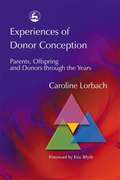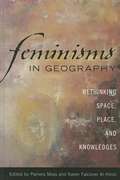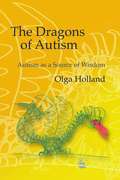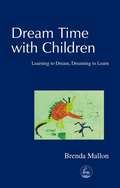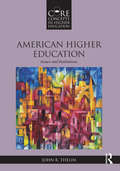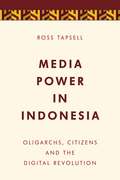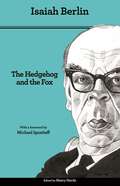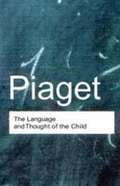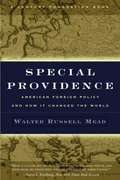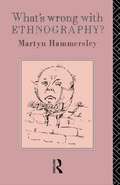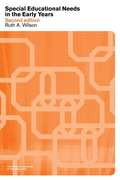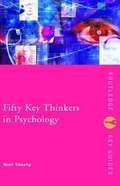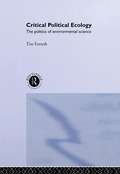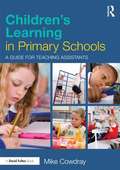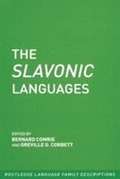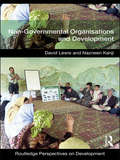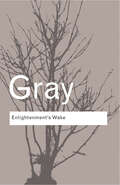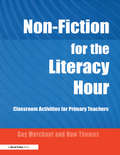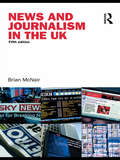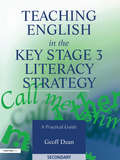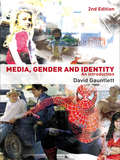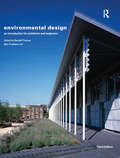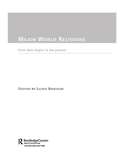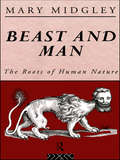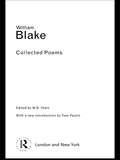- Table View
- List View
Experiences of Donor Conception: Parents, Offspring and Donors through the Years
by Caroline Lorbach Eric BlythDrawing on the experiences of parents, offspring and donors and including her own and her family's story, this thought-provoking and informative book explores the process of donor conception. From finding out about an infertility problem, to considering whether - and how - to tell the children about their conception, and how those children feel as the adult offspring of a donor, she provides practical suggestions as well as in-depth consideration of the emotional and ethical issues involved. Lorbach takes the reader step-by-step through the process of deciding to use donor conception, choosing a donor, and discussing the decision with others - and considers the perspective of the donor alongside those of parents and offspring. Tackling difficult subjects such as disclosure and offspring's access to information about the donor, this important book is a much-needed resource for health, counseling and social work professionals as well as for the couples and families themselves.
Feminisms In Geography: Rethinking Space, Place, And Knowledges (PDF)
by Linda Peake Geraldine Pratt Parvati Raghuram Joos Droogleever Fortuijn Pamela Moss (Contribution by Editor Reshma Ansari Vibha Bajpayee Sybille Bauriedl Kath Browne Kim England Karen Falconer Al-HindiIn this innovative reader, Pamela Moss and Karen Falconer Al-Hindi present a unique, reflective approach to what feminist geography is and who feminist geographers are. Their carefully crafted textbook invigorates feminist debates about space, place, and knowledges with a fine balance among teaching chapters, reprints, and original essays. Offering an anthology that actually questions the very purpose of an anthology, the editors create and then negotiate a tension between reinforcing and destabilizing scholarly authority. They challenge the idea that there is one set of works that acts as the vision, interpretation, voice, and feel of feminist geography while both reproducing key previously published works and including fresh essays from a number of feminist geographers in a single volume. The first chapter frames feminism, geography, and knowledge as a melange of ideas, principles, and practices. Each of the three major sections of the volume begins with an introductory essay that places individual contributions into the overarching argument about the construction of feminist geography. Each introduction is then followed by a combination of reprints and original essays that contribute both to understanding how feminist geographical knowledge is constructed differently in different places and to showing what feminist geographers do wherever they are. The final chapter extends the anti-anthology arguments and raises questions that feminisms in geographies have yet to address. Students and scholars will find both the approach and the discussion essential for a full and nuanced understanding of feminist geography. Contributions by: Sybille Bauriedl, Kath Browne, Joos Droogleever Fortuijn, Kim England, Karen Falconer Al-Hindi, Anne-Francoise Gilbert, Melissa R. Gilbert, Ellen Hansen, Susan Hanson, Audrey Kobayashi, Clare Madge, Michele Masucci, Janice Monk, Pamela Moss, Ann M. Oberhauser, Linda Peake, Geraldine Pratt, Parvati Raghuram, Bernadette Stiell, Amy Trauger, Dina Vaiou, The Sangtin Writers: Anupamlata, Ramsheela, Reshma Ansari, Vibha Bajpayee, Shashi Vaish, Shashibala, Surbala, Richa Singh, and Richa Nagar
The Dragons of Autism: Autism as a Source of Wisdom (PDF)
by Olga HollandWhen a child is diagnosed with autism, the parents' initial reaction is often one of hopelessness and fear that nothing can be done. Olga Holland experienced these emotions when her son Billy was diagnosed, but instead of giving up hope, she developed strategies to contain Billy's autistic behaviors, and since then she and her family have come to view autism as a blessing, not a curse. In this book Olga describes the real-world strategies that have made Billy better able to cope with life, reducing his meltdowns and helping him to accept variety and change, and she explains how working with autism's many strengths has led to a better quality of life for all her family. Full of advice for both day-to-day living and long-term progress, The Dragons of Autism is a positive and inspirational read, with Olga's deep love for her son evident throughout.
Dream Time with Children: Learning to Dream, Dreaming to Learn (PDF)
by Brenda Mallon'Brenda Mallon's latest book on dreams and dreaming provides a valuable and positive insight into the dreams of children. She has - through sensitivity, empathy and respect - won the trust of the children she has spoken to, and they have in turn shared their dreams with her. Brenda Mallon has written a book that will be a valuable resource to parents as well as professionals working with children. She has provided an excellent book list for children on the subject of sleep and dreams and there is a very comprehensive bibliography. I would recommend this book, both for the subject material and the manner in which it is presented.' - Rostrum 'This is an enjoyable read by an author who has already written widely about children and grief ("Helping children manage loss"). Although the book is not directly about bereavement, it will be most helpful to parents who are trying to help children disturbed by their dreams and it includes many wonderful quotations from youngsters on the subject such as "They are pictures in my pillow" and "We dream to rewind our memory". The great strength of this book, however, is that the author gives adults many practical and useful ways for helping children when troubled. She is clear that dreams are real, powerful and a part of our lives, whether we remember them or not. We can support our children by paying attention to their dreams and not dismissing them or brushing them aside because they are uncomfortable.' - The Compassionate Friends Newsletter UK 'An excellent book to help adults understand the fears and insecurities that can cause children to dream. Brenda Mallon, prominent in the field of dream research for more than 20 years, hopes her book will enable those who care for and work with children to realise that children's deepest anxieties signal to us through dreams. There are chapters on nightmare taming and the impact of illness, as well as ideas on how to set up a dream sharing group. This is a helpful way to let children talk about their dreams and understand why they have them.' - The Teacher 'Dream Time with Children is short, easy and fun to read, with enough introductory information that any parent, even a complete novice, could use it to begin dream sharing with children. At the same time, the most experienced dream worker will find much of interest here. A wonderful introduction to the world of children's dreams.' - Richard A. Russo, Dream Time: the magazine of the Association for the Study of Dreams 'A fascinating and readable book. Using vivid examples, Brenda Mallon explains how and why children dream, and makes connections with universal dream themes and symbols. She subscribes to Jung's theory of multiple layers in dreams. Practical guidance is given on how to help children express their dreams individually or in a group. She analyses Harry Potter's dark dreams, alerting us to the signals being sent out by nightmares, which can denote fear of separation, abandonment or attack. But she ends by reminding us how uplifting and creative dreaming can be.' - Community Care Children may not understand where their dreams come from especially when they experience terrifying nightmares that stop them being able to sleep, and frighten them when they are awake. What can an adult do to help them overcome their nightmares? How do you know what is `normal' dreaming for their age and development? Accessible and fun to use, this guide gives a step-by-step account of how to understand and interpret children's dreams. Illustrated with practical exercises it also contains interesting facts about the cultural and spiritual significance of dreams. Dream Time with Children even includes an analysis of Harry Potter's dreams - as well as a fascinating look at dreams real children have experienced.
American Higher Education: Issues and Institutions
by John R. ThelinHigher education in the United States is a complex, diverse, and important enterprise. The latest book in the Core Concepts in Higher Education series brings to life issues of governance, organization, teaching and learning, student life, faculty, finances, college sports, public policy, fundraising, and innovations in higher education today. Written by renowned author John R. Thelin, each chapter bridges research, theory, and practice and discusses a range of institutions – including the often overlooked for-profits, community colleges, and minority serving institutions. A blend of stories and analysis, this exciting new book challenges present and future higher education practitioners to be informed and active participants, capable of improving their institutions.
Media Power in Indonesia: Oligarchs, Citizens and the Digital Revolution (PDF)
by Ross TapsellIndonesia is undergoing a process of rapid change, with an affluent middle class due to hit 141 million people by 2020. While official statistics suggest that internet penetration is low, over 70 million Indonesians have a Facebook account, the fourth highest group in the world. Jakarta is the Twitter capital of the world with more tweets per minute than any other city around the globe. In the past ten years digitalisation of media content has enabled extensive concentration and conglomeration of the industry, and media owners are wealthier and more politically powerful than ever before. Digital media is a prominent place of contestation between large, powerful oligarchs, and citizens looking to bring about rapid and meaningful change. This book examines how the political agencies of both oligarchs and 'netizens' are enhanced by digitalisation, and how an increasingly divergent society is being formed. In doing so, this book enters this debate about the transformations of society and power in the digital age.
The Hedgehog and the Fox: An Essay on Tolstoy’s View of History, Second Edition
by Isaiah Berlin Henry Hardy Michael Ignatieff"The fox knows many things, but the hedgehog knows one big thing." This ancient Greek aphorism, preserved in a fragment from the poet Archilochus, describes the central thesis of Isaiah Berlin's masterly essay on Leo Tolstoy and the philosophy of history, the subject of the epilogue to War and Peace. Although there have been many interpretations of the adage, Berlin uses it to mark a fundamental distinction between human beings who are fascinated by the infinite variety of things and those who relate everything to a central, all-embracing system. Applied to Tolstoy, the saying illuminates a paradox that helps explain his philosophy of history: Tolstoy was a fox, but believed in being a hedgehog. One of Berlin's most celebrated works, this extraordinary essay offers profound insights about Tolstoy, historical understanding, and human psychology. This new edition features a revised text that supplants all previous versions, English translations of the many passages in foreign languages, a new foreword in which Berlin biographer Michael Ignatieff explains the enduring appeal of Berlin's essay, and a new appendix that provides rich context, including excerpts from reviews and Berlin's letters, as well as a startling new interpretation of Archilochus's epigram.
The Language And Thought Of The Child (PDF)
by Jean Piaget Gabain Marjorie Gabain RuthThis book is for anyone who has ever wondered how a child develops language, thought, and knowledge. Before this classic appeared, little was known of the way children think. In 1923, however, Jean Piaget, the most important developmental psychologist of the twentieth century, took the psychological world by storm with The Language and Thought of the Child. Applying for the first time the insights of social psychology and psychoanalysis to the observation of children, he uncovered the ways in which a child actively constructs his or her understanding of the world through language. The book has since been a source of inspiration and guidance to generations of parents and teachers. While its conclusions remain contentious to this very day, few can deny the huge debt we owe to this pioneering work in our continuing attempts to understand the minds of the child.
Special Providence: American Foreign Policy And How It Changed The World (PDF)
by Walter Russell Mead"God has a special providence for fools, drunks and the United States of America. "--Otto von Bismarck America's response to the September 11 attacks spotlighted many of the country's longstanding goals on the world stage: to protect liberty at home, to secure America's economic interests, to spread democracy in totalitarian regimes and to vanquish the enemy utterly. One of America's leading foreign policy thinkers, Walter Russell Mead, argues that these diverse, conflicting impulses have in fact been the key to the U. S. 's success in the world. In a sweeping new synthesis, Mead uncovers four distinct historical patterns in foreign policy, each exemplified by a towering figure from our past. Wilsonians are moral missionaries, making the world safe for democracy by creating international watchdogs like the U. N. Hamiltonians likewise support international engagement, but their goal is to open foreign markets and expand the economy. Populist Jacksonians support a strong military, one that should be used rarely, but then with overwhelming force to bring the enemy to its knees. Jeffersonians, concerned primarily with liberty at home, are suspicious of both big military and large-scale international projects. A striking new vision of America's place in the world, Special Providence transcends stale debates about realists vs. idealists and hawks vs. doves to provide a revolutionary, nuanced, historically-grounded view of American foreign policy.
What's Wrong With Ethnography? (PDF)
by Martyn HammersleyThis stimulating and refreshing study, written by one of the leading commentators in the field, provides novel answers to these crucial questions. "What's Wrong With Ethnographyprovides a fresh look at the rationale for and distinctiveness of ethnographic research in sociology, education and related fields, and succeeds in slaying a number of currently fashionable sacred cows. Relativism, critical theory, the uniqueness of the case study and the distinction between qualitative and quantitative research are all examined and found wanting as a basis for informed ethnography. The policy and political implications of ethnography are a particular focus of attention. The author compels the reader to reexamine some basic methodological assumptions in an exciting way", Martin Bulmer, London School of Economics.
Special Educational Needs In The Early Years (PDF)
by Ruth A. WilsonHow can we help children with special needs become active learners? This book is a practical and accessible guide to teaching young children with special educational needs. At the heart of the book is the belief that the focus should be on the child as an active learner, rather than on their disability. This fully revised and updated edition takes into account current changes in educational policy to provide the reader with comprehensive information and understanding and working with young children with special needs. The author addresses key issues such as the nature and causes of specific disabilities, intervention and assessment, working with families, planning individualised objectives and instructional strategies. There are also new sections on emotional competence, early literacy concerns and discussions of the emotional implications of brain research. Case study examples and practical suggestions are included throughout. The book will be a valuable resource for all early years practitioners, primary teachers, student teachers and learning support assistants.
Fifty Key Thinkers in Psychology (PDF)
by Noel Sheehy Alexandra ForsytheThis book introduces the life, thought, work and impact of fifty of the most influential figures who have shaped and developed psychology, including: - Sigmund Freud - Noam Chomsky - William James - Carl Jung - Ivan Pavlov - Jean Piaget - Anne Anastasi - Abraham Maslow - Konrad Lorenz - Hans Eysenck Accessibly written, with full cross-referencing and helpful pointers to further reading, this fascinating and informative guide is an invaluable resource for those studying, working in, or who simply want to find out more about psychology.
Critical Political Ecology: The Politics of Environmental Science (PDF)
by Tim ForsythCritical Political Ecology brings political debate to the science of ecology. As political controversies multiply over the science underlying environmental debates, there is an increasing need to understand the relationship between environmental science and politics. In this timely and wide-ranging volume, Tim Forsyth uses an innovative approach to apply political analysis to ecology, and demonstrates how more politicised approaches to science can be used in environmental decision-making. Critical Political Ecology examines: *how social and political factors frame environmental science, and how science in turn shapes politics *how new thinking in philosophy and sociology of science can provide fresh insights into the biophysical causes and impacts of environmental problems *how policy and decision-makers can acknowledge the political influences on science and achieve more effective public participation and governance.
Children's Learning In Primary Schools: A Guide For Teaching Assistants
by Bernard Comrie Greville G. Corbett Victor Friedman Lenore GrenobleIn this scholarly volume, each of the living Slavonic languages are analysed and described in depth, together with the two extinct languages - Old Church Slavonic and Polabian. In addition, the various alphabets of the Slavonic languages - particularly Roman, Cyrillic and Glagolitic - are discussed, and the relationships of the Slavonic languages to other Indo-European languages and to one another, are explored. The last chapter provides an account of those Slavonic languages in exile, for example, Russian, Ukrainian, Polish, Czech and Slovak in the USA. Each language-chapter is written by an expert in the field, in a format designed for comparative study. Information on each language includes: an introductory description of social context and development (where appropriate); a discussion of phonology; a detailed presentation of synchronic morphology, noting major historical developments; comprehensive treatment of syntactic properties; a discussion of vocabulary; an outline of main dialects; and an extensive bibliography, listing English and other sources.
The Slavonic Languages (PDF)
by Bernard Comrie Greville G. Corbett Victor Friedman Lenore GrenobleIn this scholarly volume, each of the living Slavonic languages are analysed and described in depth, together with the two extinct languages - Old Church Slavonic and Polabian. In addition, the various alphabets of the Slavonic languages - particularly Roman, Cyrillic and Glagolitic - are discussed, and the relationships of the Slavonic languages to other Indo-European languages and to one another, are explored. The last chapter provides an account of those Slavonic languages in exile, for example, Russian, Ukrainian, Polish, Czech and Slovak in the USA. Each language-chapter is written by an expert in the field, in a format designed for comparative study. Information on each language includes: an introductory description of social context and development (where appropriate); a discussion of phonology; a detailed presentation of synchronic morphology, noting major historical developments; comprehensive treatment of syntactic properties; a discussion of vocabulary; an outline of main dialects; and an extensive bibliography, listing English and other sources.
Non-Governmental Organizations and Development
by David Lewis Nazneen KanjiNon-governmental organizations (NGOs) are high profile actors in the field of international development, both as providers of services to vulnerable individuals and communities and as campaigning policy advocates. This book provides a critical introduction to the wide-ranging topic of NGOs and development. Written by two authors with more than twenty years experience of research and practice in the field, the book combines a critical overview of the main research literature with a set of up-to-date theoretical and practical insights drawn from experience in Asia, Europe, Africa and elsewhere. It highlights the importance of NGOs in development, but it also engages fully with the criticisms that the increased profile of NGOs in development now attracts. Non-Governmental Organizations and Development begins with a discussion of the wide diversity of NGOs and their roles, and locates their recent rise to prominence within broader histories of struggle as well as within the ideological context of neo-liberalism. It then moves on to analyze how interest in NGOs has both reflected and informed wider theoretical trends and debates within development studies, before analyzing NGOs and their practices, using a broad range of short case studies of successful and unsuccessful interventions. David Lewis and Nazneen Kanji then moves on to describe the ways in which NGOs are increasingly important in relation to ideas and debates about ‘civil society’, globalization and the changing ideas and practices of international aid. The book argues that NGOs are now central to development theory and practice and are likely to remain important actors in development in the years to come. In order to appreciate the issues raised by their increasing diversity and complexity, the authors conclude that it is necessary to deploy a historically and theoretically informed perspective. This critical overview will be useful to students of development studies at undergraduate and masters levels, as well as to more general readers and practitioners. The format of the book includes figures, photographs and case studies as well as reader material in the form of summary points and questions. Despite the growing importance of the topic, no single short, up-to-date book exists that sets out the main issues in the form of a clearly written, academically-informed text: until now.
Enlightenment's Wake: Politics and Culture at the Close of the Modern Age
by John GrayJohn Gray is the bestselling author of such books as Straw Dogs and Al Qaeda and What it Means to be Modern which brought a mainstream readership to a man who was already one of the UK's most well respected thinkers and political theorists. Gray wrote Enlightenment’s Wake in 1995 – six years after the fall of the Berlin Wall and six years before the terrorist attacks on the World Trade Center. Turning his back on neoliberalism at exactly the moment that its advocates were in their pomp, trumpeting 'the end of history' and the supposedly unstoppable spread of liberal values across the globe, Gray’s was a lone voice of scepticism. The thinking he criticised here would lead ultimately to the invasion of Iraq. Today, its folly might seem obvious to all, but as this edition of Enlightenment’s Wake shows, John Gray has been trying to warn us for some fifteen years – the rest of us are only now catching up with him.
Non-Fiction for the Literacy Hour: Classroom Activities for Primary Teachers
by Guy Merchant Huw ThomasThis book offers practical guidance for teachers using the National Literacy Strategy at Key Stages 1 and 2, based on the six categories of non-fiction outlined in the Strategy. It gives an accessible introduction to the features of each of these text types. Many teachers now feel confident in working with fiction and poetry, whereas the non-fiction objectives have been more challenging. The book includes new subject knowledge, such as understanding the linguistic features of different text types, and the need to find authentic reading material; practical classroom examples; high-quality photocopiable texts and activity sheets; and detailed guidance on how to work with the material at text, sentence and word level. Each chapter consists of a description of the genre, a text example, a photocopiable double-page spread giving an annotated version of the text, details of the classroom resources for developing the ideas and activity sheets for each text. The book will appeal to all teachers and student teachers working at Key Stages 1 and 2, English and Literacy advisers in LEAs, and providers of initial and in-service training.
News and Journalism in the UK
by Brian McNairNews and Journalism in the UK is an accessible and comprehensive introduction to the political, economic and regulatory environments of press and broadcast journalism in Britain and Northern Ireland. Surveying the industry in a period of radical economic and technological change, Brian McNair examines the main trends in journalistic media in the last two decades and assesses the challenges and future of the industry in the new millennium. Integrating both academic and journalistic perspectives on journalism, topics addressed in this revised and updated edition include: the rise of online journalism and the impact of blogging on mainstream journalism the emergence of 24 hour news channels in the UK the role and impact of journalism, with reference to issues such as democracy, health scares and the war on terror trends in media ownership and editorial allegiances 'Tabloidisation', Americanisation and the supposed 'dumbing down' of journalistic standards the implications of devolution for regional journalists.
Teaching English in the Key Stage 3 Literacy Strategy
by Geoff DeanThis book will supplement the training currently being offered to all secondary English departments. It offers a view of the place of the English 'strand' in the overall Key Stage 3 strategy and gives support to English departments in their preparations for a new way of working. It will encourage English teachers to review their current schemes of work, offering suggestions for more substantial teaching and learning modules, as well as practical ideas for classroom use and recommended resources. The book interprets and explains the NLS document for busy practitioners; reinforces the messages of the National Literacy Strategy (NLS); spells out the expectations of the framework and offer guidance on how to fulfil them; and describes and explains the types of teaching methods to improve students' learning. This book includes many practical ideas for classroom activities and offers direct support for the less confident English teacher. The book is equally valuable to students and practicing teachers.
Media, Gender and Identity: An Introduction
by David GauntlettPopular media present a vast array of stories about women and men. What impact do these images and ideas have on people’s identities? The new edition of Media, Gender and Identity is a highly readable introduction to the relationship between media and gender identities today. Fully revised and updated, including new case studies and a new chapter, it considers a wide range of research and provides new ways for thinking about the media’s influence on gender and sexuality. David Gauntlett discusses movies such as Knocked Up and Spiderman 3, men’s and women’s magazines, TV shows, self-help books, YouTube videos, and more, to show how the media play a role in the shaping of individual self-identities. The book includes: a comparison of gender representations in the past and today, from James Bond to Ugly Betty an introduction to key theorists such as Judith Butler, Anthony Giddens and Michel Foucault an outline of creative approaches, where identities are explored with video, drawing, or Lego bricks a Companion Website with extra articles, interviews and selected links, at: www.theoryhead.com.
Environmental Design: An Introduction for Architects and Engineers
by Randall ThomasWritten and edited by a team of specialists at Max Fordham LLP, one of the UK’s leading environmental and building services engineering consultancies, Environmental Design is the result of their extensive experience in designing environmentally-friendly buildings. The principles of their approach, which they have taught in numerous schools of architecture and engineering, are clearly presented here. The book starts with some basic scientific principles and environmental issues and then moves on to site planning, energy use, materials and building form. Natural ventilation systems, high-efficiency mechanical equipment and alternative energy sources are also covered. State-of-the-art buildings of exceptional quality are incorporated throughout the text and illustrate the authors’ belief that environmentally responsible architecture can be visually exciting. They conclude with a selection of detailed case studies of award-winning projects – including, new for this third edition, Beaufort Court, King's Langley and the National Trust Headquarters, Swindon. This book is essential reading for architects, engineers, planners and students of these disciplines.
Major World Religions: From Their Origins To The Present
by Lloyd RidgeonThis work seeks to answer questions about the great religious traditions in the contemporary age. It focuses upon those religions that continue to demand the attention of the Western world. Following an introduction on the philosophy of religion, attention is focused on Hinduism, Buddhism, Judaism, Christianity, and Islam which are religions that have had (and probably continue to have) the greatest number of followers in Western society. In addition to the lasting impact that religion has had in society, we are witnesses to the development of secularism on the one hand and the revival of religious sentiment on the other, thus chapters on modernity, postmodernism, and 'fundamentalism' have also been included. The distinctive feature of the book is its modern feel. Each chapter brings the reader up-to-date with recent developments and commentaries upon recent religious thought, theology and religious-political movements. Moreover, the length of the chapters permits a detailed analysis which is so often lacking in books on world religions.
Beast and Man: The Roots of Human Nature
by Mary MidgleyPhilosophers have traditionally concentrated on the qualities that make human beings different from other species. In Beast and Man Mary Midgley, one of our foremost intellectuals, stresses continuities. What makes people tick? Largely, she asserts, the same things as animals. She tells us humans are rather more like other animals than we previously allowed ourselves to believe, and reminds us just how primitive we are in comparison to the sophistication of many animals. A veritable classic for our age, Beast and Man has helped change the way we think about ourselves and the world in which we live.
Collected Poems
by William Blake W. B YeatsWilliam Blake is a poet without parallel, who remains a source of wisdom and inspiration to countless individuals throughout the world. This selection was commissioned in 1905 by the firm of George Routledge from W.B. Yeats, who had previously been one of the pioneer editors of Blake's prophetic books. Yeats, one of the few poets whose work could be compared with that of Blake, prepared a unique selection of his poetic and prose writings. There is no better way to encounter the work of one poetic genius than as it is presented by another, and Yeats understood Blake in a way few others did.
